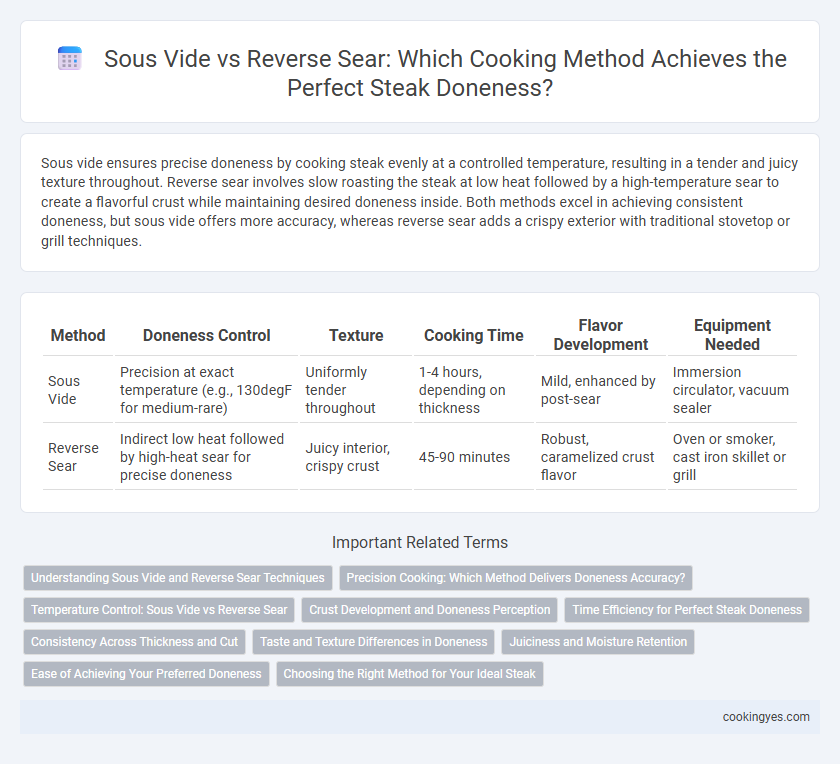Sous vide ensures precise doneness by cooking steak evenly at a controlled temperature, resulting in a tender and juicy texture throughout. Reverse sear involves slow roasting the steak at low heat followed by a high-temperature sear to create a flavorful crust while maintaining desired doneness inside. Both methods excel in achieving consistent doneness, but sous vide offers more accuracy, whereas reverse sear adds a crispy exterior with traditional stovetop or grill techniques.
Table of Comparison
| Method | Doneness Control | Texture | Cooking Time | Flavor Development | Equipment Needed |
|---|---|---|---|---|---|
| Sous Vide | Precision at exact temperature (e.g., 130degF for medium-rare) | Uniformly tender throughout | 1-4 hours, depending on thickness | Mild, enhanced by post-sear | Immersion circulator, vacuum sealer |
| Reverse Sear | Indirect low heat followed by high-heat sear for precise doneness | Juicy interior, crispy crust | 45-90 minutes | Robust, caramelized crust flavor | Oven or smoker, cast iron skillet or grill |
Understanding Sous Vide and Reverse Sear Techniques
Sous vide cooking involves vacuum-sealing steak and immersing it in a precisely controlled water bath, ensuring consistent internal doneness throughout. Reverse sear heats the steak slowly at low temperatures followed by a high-heat sear to create a caramelized crust while maintaining the desired internal temperature. Sous vide guarantees uniform temperature and tenderness, whereas reverse sear prioritizes a balance between an even cook and a flavorful crust.
Precision Cooking: Which Method Delivers Doneness Accuracy?
Sous vide offers unparalleled precision cooking by maintaining a consistent water temperature, ensuring steak doneness is exact and uniform throughout the cut. Reverse sear involves slow roasting followed by a high-heat sear, which can result in slight variations in interior temperature, especially near the edges. For pinpoint accuracy in achieving desired doneness, sous vide remains the superior method.
Temperature Control: Sous Vide vs Reverse Sear
Sous vide cooking provides precise temperature control by immersing the steak in a water bath set to the exact desired doneness, ensuring uniform cooking edge-to-edge. Reverse sear relies on oven temperature followed by high-heat searing, which can create slight variability in doneness as internal temperature continues to rise after searing. Sous vide offers superior repeatability and precision, maintaining steak doneness consistently at target temperatures like 129degF (54degC) for medium-rare.
Crust Development and Doneness Perception
Sous vide cooking offers precise control over internal doneness by cooking steak evenly at a low temperature, but often results in a less developed crust requiring a finishing sear for texture and flavor. Reverse sear enhances crust development by first gently cooking the steak and then searing at high heat, creating a flavorful Maillard reaction while maintaining the desired internal temperature. Crust development significantly influences doneness perception, as a well-browned exterior enhances texture contrast and flavor complexity, affecting overall steak enjoyment.
Time Efficiency for Perfect Steak Doneness
Sous vide ensures precise doneness by cooking steak slowly at a controlled temperature, typically requiring 1 to 4 hours depending on thickness, guaranteeing uniformity from edge to center. Reverse sear significantly reduces overall cook time by first roasting steak at a low temperature for about 20-40 minutes before finishing with a high-heat sear to develop crust and achieve target doneness rapidly. For optimal time efficiency while maintaining perfect doneness, reverse sear offers a faster method compared to the longer, more precise sous vide approach.
Consistency Across Thickness and Cut
Sous vide cooking ensures precise doneness throughout steaks of varying thickness and cut by gently heating the meat to an exact temperature, preventing overcooking or undercooking. Reverse sear provides a flavorful crust by searing after slow cooking but may result in less even doneness, especially in thicker cuts where the center can vary in temperature. Consistency across different cuts is more reliably achieved with sous vide due to its controlled, uniform heat distribution.
Taste and Texture Differences in Doneness
Sous vide cooking ensures precise doneness with even texture throughout the steak, resulting in a consistently tender and juicy interior. Reverse sear produces a distinctive crust with a gradient of doneness, offering a combination of a crispy exterior and a medium-rare center. Taste differences highlight sous vide's pure meat flavor and enhanced tenderness, while reverse sear delivers robust charred notes and a more traditional steakhouse texture.
Juiciness and Moisture Retention
Sous vide cooking ensures precise temperature control, resulting in evenly cooked steak with exceptional juiciness and maximum moisture retention by sealing in natural juices during slow cooking. Reverse sear involves slow roasting followed by high-heat searing, which enhances flavor but can cause some moisture loss due to prolonged exposure to heat before searing. Steak enthusiasts seeking optimal juiciness and moisture retention often prefer sous vide for its consistent tenderness and ability to lock in fluids.
Ease of Achieving Your Preferred Doneness
Sous vide offers precise temperature control, ensuring your steak reaches the exact doneness level you prefer with minimal risk of overcooking. Reverse sear relies on slow roasting followed by high-heat searing, which may require more skill and attention to avoid overshooting the target doneness. For consistent, foolproof results, sous vide is the optimal method to achieve perfect doneness every time.
Choosing the Right Method for Your Ideal Steak
Sous vide cooking ensures precise, even doneness by immersing steak in a temperature-controlled water bath, maintaining exact internal temperature throughout. Reverse sear begins with a low oven or grill heat, then finishes with a high-temperature sear, creating a flavorful crust while gradually bringing the steak to the desired doneness. For optimal results, select sous vide when consistent doneness edge-to-edge is critical, and choose reverse sear for a traditional texture with a crispy, caramelized exterior.
Sous vide vs Reverse sear for doneness Infographic

 cookingyes.com
cookingyes.com